Glide is a relatively new no-code platform founded in 2018. It’s designed to help businesses build PWAs (progressive web apps) for internal or client use to make data more accessible and move work forward faster.
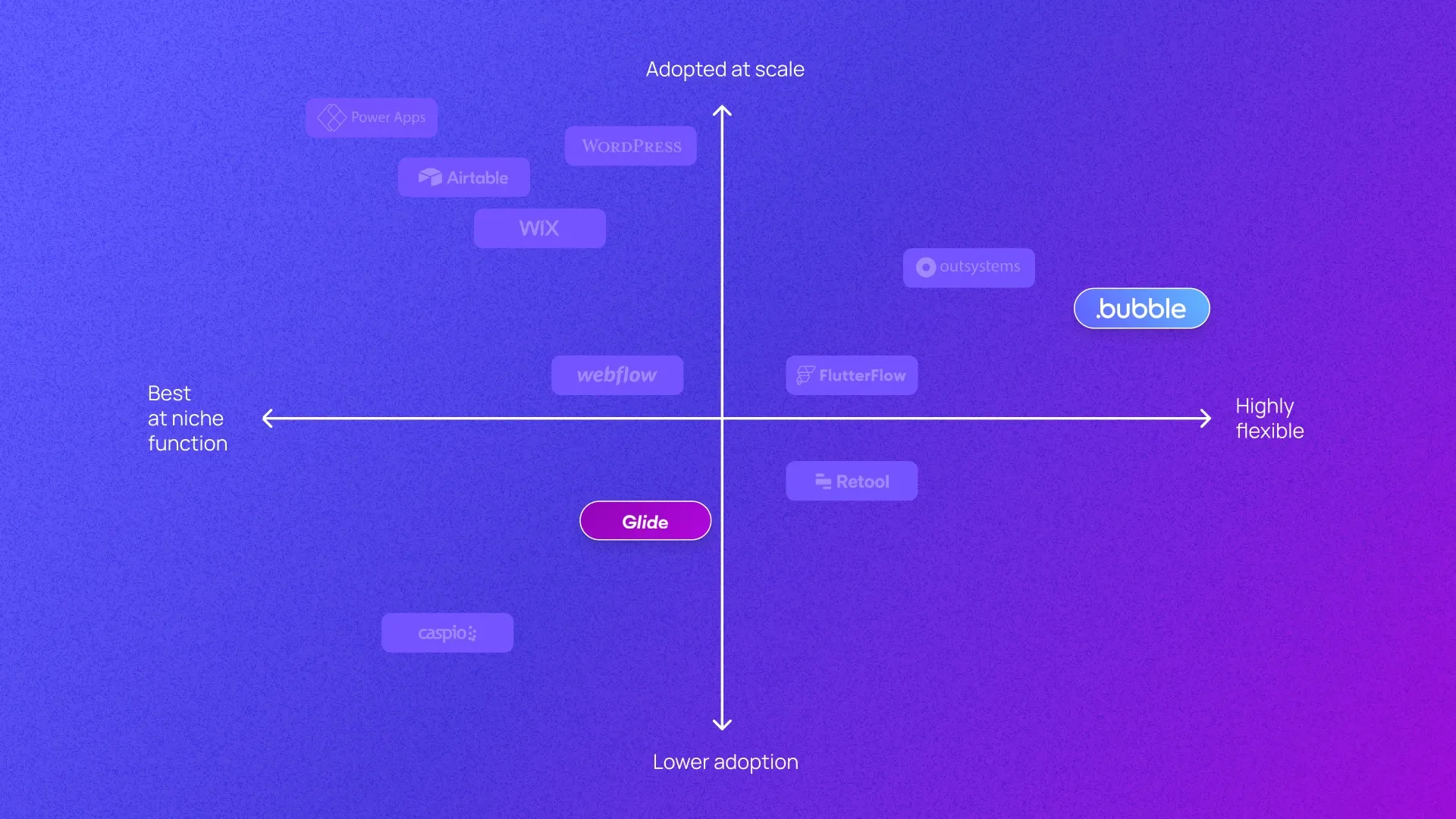
Bubble’s no-code app builder has a longer history than Glide. It’s been used to build and scale nearly 5 applications over the last 10+ years, with startups and enterprises alike choosing to build on Bubble. Like Glide, Bubble can be used to make internal tools and build simple apps on top of data. But that’s just one of the many Bubble use cases.
Both of these platforms offer full-stack solutions, so you won’t need additional services or tools to build and launch your app. But while they seem similar on the surface, Bubble and Glide have some key distinctions we’ll unpack in this guide. These distinctions will directly impact factors like:
Of course, we are Bubble, and so naturally, we’re big fans of our own platform. That’s why we tapped the wider no-code community to find out what mattered most to them when choosing a platform. Then we used their responses to develop a rubric that more objectively compares Bubble to solutions like Glide.
In this article, we’ll show you how these two platforms stack up — and you’ll see why no matter what you’re trying to build, Bubble is your best option. If you want to learn more about the process of choosing the right tech for your use case, check out our full buyer’s guide to 23 different no-code development platforms.
Glide vs. Bubble: At-a-glance comparison
Let’s start with a high-level overview of how Bubble and Glide compare.
| Glide | Bubble | |
|---|---|---|
| Common use cases | Teams choose Glide for easy-to-use software that transforms business data into a visual app. It’s great for quickly developing internal tools. | Startups and founders use Bubble to develop new products, and SMBs and enterprises use it to build internal tools. |
| Where they shine | Glide brings simplicity and ease-of-use to the no-code space with integrations with a variety of data sources. | Bubble is a full-stack no-code development platform with robust performance and a wealth of resources to help even non-technical founders get started easily. |
| Overall score | ⭐⭐⭐💫 (3.62) | ⭐⭐⭐⭐ (4.00) |
| Use-case versatility | 🟩🟩🟩🟩⬛ | 🟩🟩🟩🟩🟩 |
| Full-stack coverage | 🟩🟩🟩🟩🟩 | 🟩🟩🟩🟩🟩 |
| Performance | 🟩🟩🟩🟩⬛ | 🟩🟩🟩🟩⬛ |
| Ecosystem | 🟨🟨🟨⬛⬛ | 🟩🟩🟩🟩⬛ |
| Cost | 🟨🟨🟨⬛⬛ | 🟨🟨🟨⬛⬛ |
| Customizability | 🟨🟨🟨⬛⬛ | 🟩🟩🟩🟩⬛ |
| Compliance | 🟨🟨🟨⬛⬛ | 🟩🟩🟩🟩⬛ |
| Code ownership | 🟩🟩🟩🟩⬛ | 🟨🟨🟨⬛⬛ |
| Learning curve | 🟩🟩🟩🟩⬛ | 🟨🟨🟨⬛⬛ |
| Resources | 🟩🟩🟩🟩⬛ | 🟩🟩🟩🟩⬛ |
| Community | 🟩🟩🟩🟩⬛ | 🟩🟩🟩🟩🟩 |
We wanted to compare these platforms based on what matters most to actual no-code developers — so we asked them. In our 2024 State of No-Code Development Survey, more than 350 no-code founders, developers, freelancers, and hobbyists rated the importance of 17 factors when choosing a no-code builder. We developed these categories using their feedback.
In the summer of 2024, we scored Bubble and Glide from 1–5 in each of these areas, with 5 being the best score. Each score had specific requirements, and we’ll explain more about those below.
We also gave each platform an overall score using a weighted average. This was based on how important the category was to no-code developers in the survey. Here’s how Bubble and Glide compared.
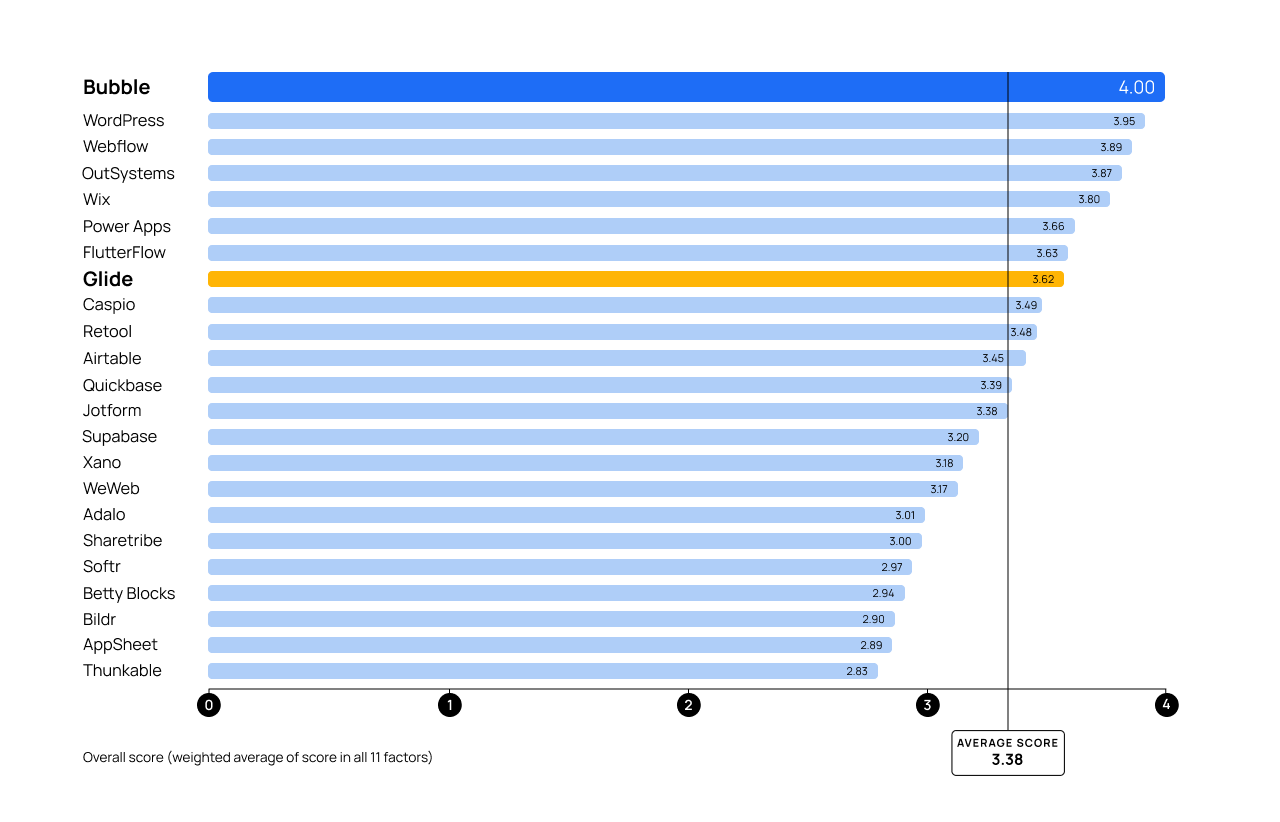
Glide vs. Bubble on use-case versatility
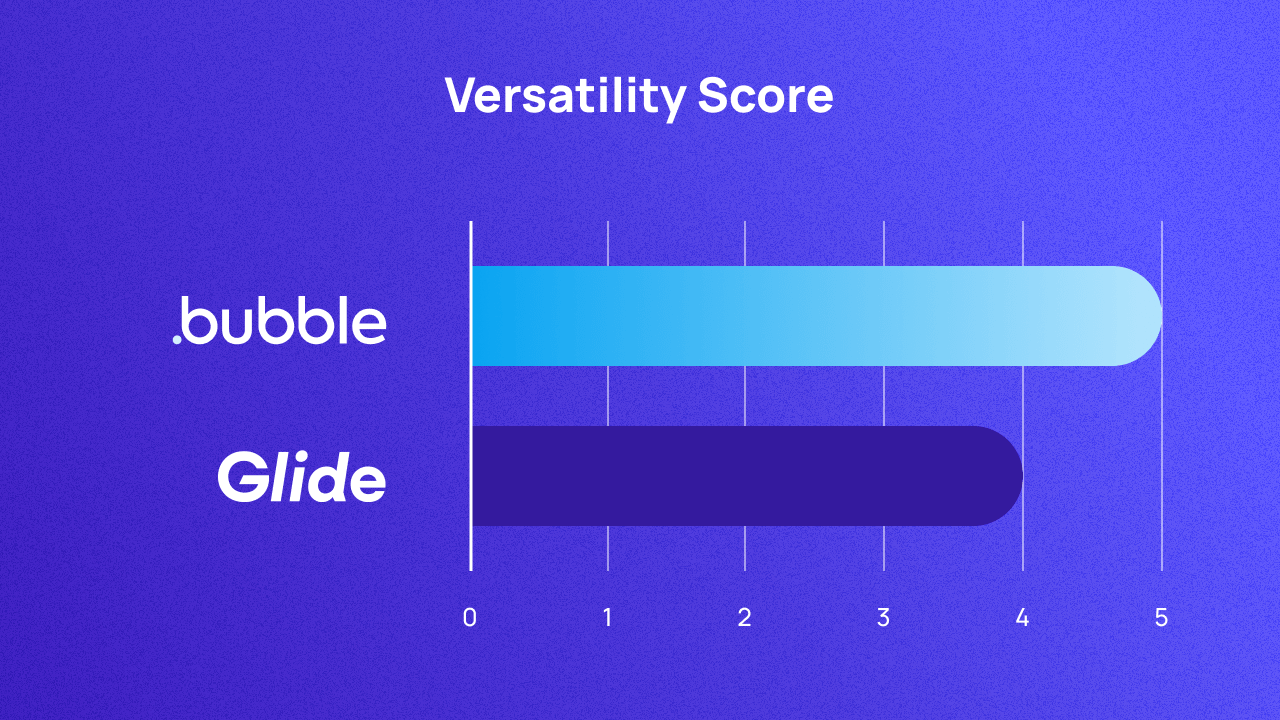
Give a kid a cardboard box and you may soon have a magical castle, a rocket ship, a kitchen, or a cave with an angry bear inside.
A good no-code platform is the same way — a semi-blank slate that allows you to use your imagination to create whatever you’re dreaming of. But many no-code platforms are designed for a specific purpose. Trying to use them for something outside of that purpose may be an uphill battle.
And while some no-code platforms support a variety of use cases, you may find that most customers tend to use it for a specific use case, like testing an MVP or iterating on a design.
In general, a platform can be limited by its capabilities or its community. That is, you certainly could use Figma for wireframing and writing your website’s blog content, but since it’s not designed for that, and most users don’t use it for that, you’ll be working against the grain. It will likely be more difficult than just using another tool, like Google Docs, and the Figma team likely will (rightfully) focus on what the majority of its user base wants.
Our scores for use-case versatility attempt to take this into account, rating each platform based on the range of use cases most people choose them for.
| Score | Criteria |
|---|---|
| 1 | Not particularly well-known or well-perceived by the market for any use cases |
| 2 | Narrow set of use cases as perceived by the market |
| 3 | Use-case versatility across app types or industries, but not both. |
| 4 | Use-case versatility across either app types or industries, with some use-case versatility in the other category |
| 5 | Shown to be proficiently versatile across both app types and industries |
How Glide stacks up: Glide users have built all kinds of apps, but they more or less fall into the category of internal tools to make business operations smoother.
As such, Glide is very versatile for almost any industry, but has a more limited use case within them. Many Glide apps provide ways to manage and interact with internal data, such as project management or CRM tools, portals, dashboards, knowledge bases, and so on.
Glide’s versatility score: 4/5
How Bubble compares: People use Bubble to build all kinds of full-stack apps.
With nearly 5 million apps created in Bubble, you’ll find a ton of use cases, from specialized industry-specific apps and internal tools to social apps, marketplaces, websites, one-off landing pages, and more. Bubble can also be a frontend only solution, a backend only solution, or a full-stack solution.
You have the flexibility to build different kinds of software in a wide range of industries, and it shows in the kinds of products our customers create.
Bubble’s versatility score: 5/5
Glide vs. Bubble on full-stack coverage
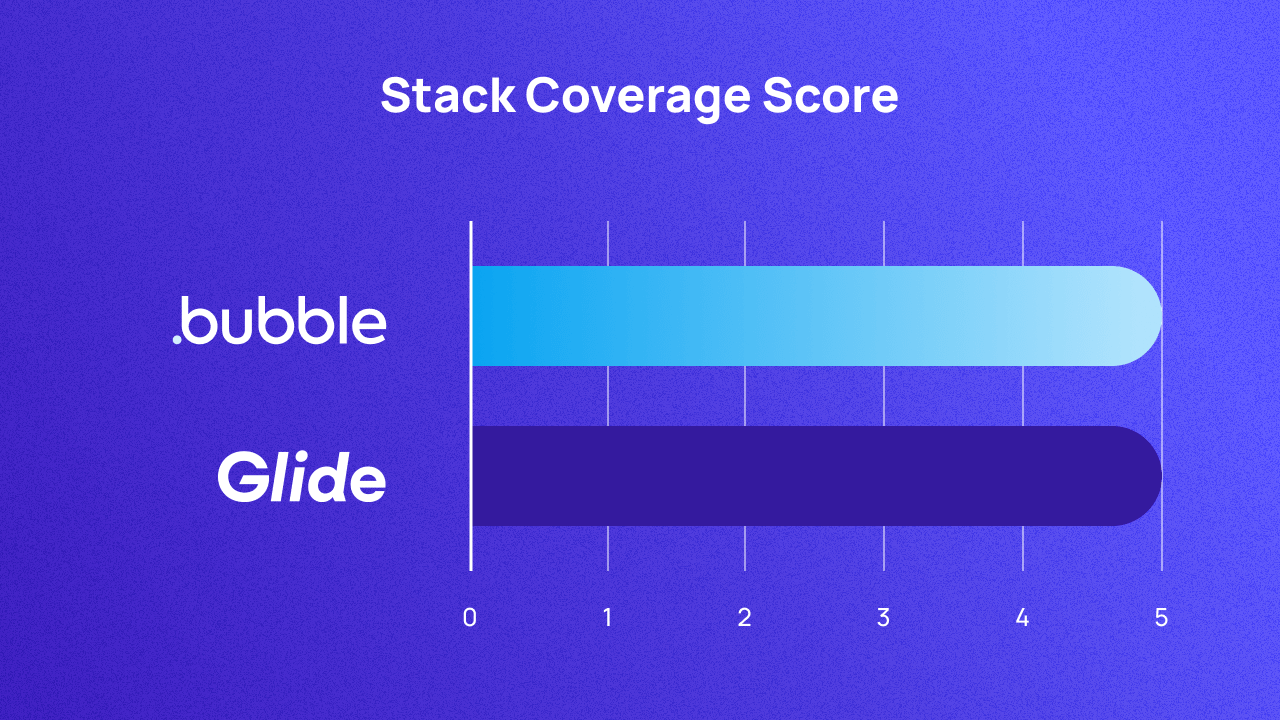
Many no-code platforms focus on one or two specific aspects of development: design, data, and logic. As such, you have to either build the other components yourself with traditional code, or combine platforms to support all three components. This can raise your costs and development time, while also making your development process more complicated.
We scored Bubble and Glide based on how many of three components (design, data, logic) users can access — in other words, the degree to which the platform is a “full stack” solution.
| Score | Criteria |
|---|---|
| 1 | Capabilities in one area: design, data, or logic |
| 2 | Capabilities in one area, gives user limited access to another |
| 3 | Capabilities in two areas |
| 4 | Capabilities in two areas, gives user limited access to the third |
| 5 | Full-stack: Capabilities in design, data, and logic |
How Glide stacks up: Glide earns a score of 5 in this category for allowing users to manage design, data, and logic all in one tool. However, Glide’s capabilities in this area are somewhat limited compared to other full-stack tools.
For example, Glide’s design features rely on templates, giving users a great foundation for good UX and UI while also being easy to use. However, they have limited customization, especially on individual plans. This means that you might get stuck within certain layouts or options and not be able to fully control the design.
Glide data and logic are managed with Glide Tables, which are a spreadsheet-based database solution. Similar to Google Sheets, it’s very simple to use, but does limit your options — especially in comparison to Bubble’s relational database.
Glide’s stack coverage score: 5/5
How Bubble compares: Bubble also provides a full-stack, no-code development platform that doesn’t have to be combined with any other solutions. You have full control over your app’s design, data, and logic. Additionally, with Bubble, you can fully customize the look, feel, and functionality, either directly with the visual editor or by adding custom code to achieve exactly what you’re going for.
Bubble offers templates to get you started on both designs and workflows, with the option of customizing any element to your exact needs. Besides that, uniquely robust database management allows you to handle dynamic and complex data from multiple data sources without having to write SQL queries or manage database schema.
Bubble’s stack coverage score: 5/5
Glide vs. Bubble on performance
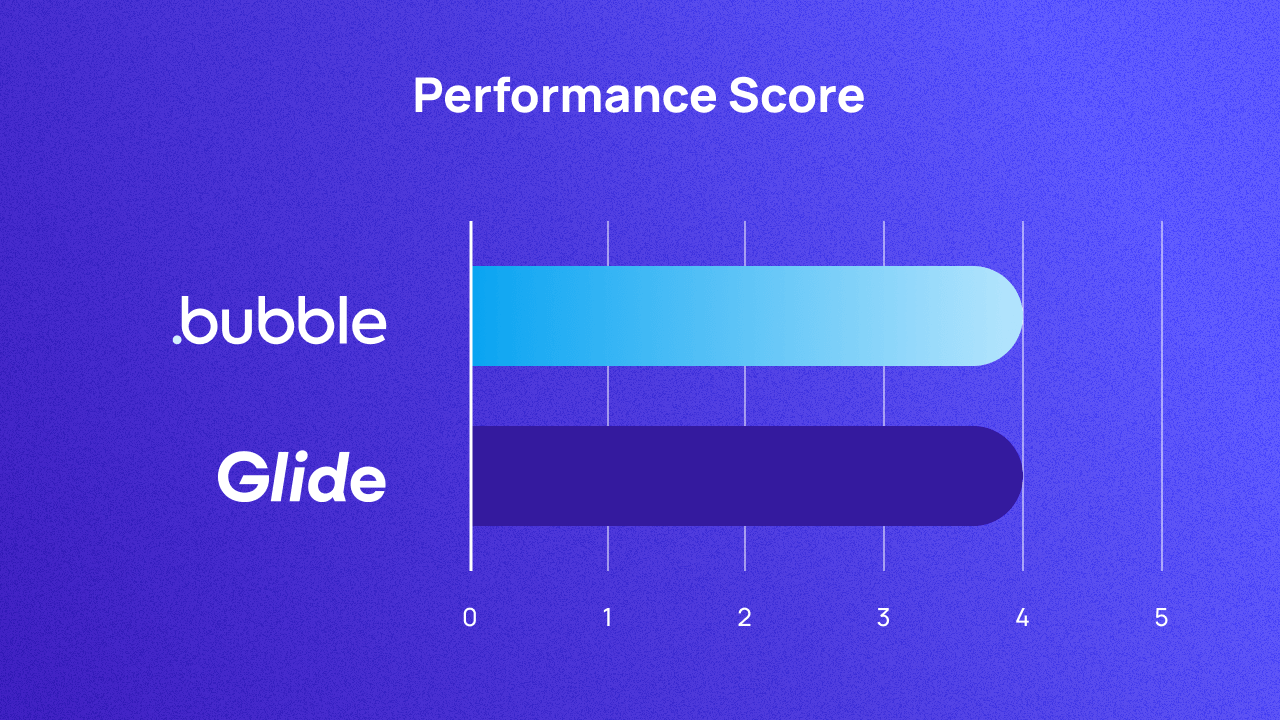
Performance is the foundation of a good no-code builder. After all, regardless of how much customization, features, ease-of-use, or anything else, if your chosen platform isn’t reliable, it’s a bust.
Your own app will only be as reliable as the software you use to make it. So you need to find a no-code software that has very few problems. And when outages happen, you need to trust that your vendor will fix the problem quickly and give you clear updates about the problem and how it’s fixed.
When comparing Bubble and Glide, we took into account how the platform performs as you scale up server demand. That is, can the platform grow with you, or does performance take a hit when your user base grows too large?
| Score | Criteria |
|---|---|
| 1 | Frequent outages |
| 2 | Outages scale with user growth and/or company has no status page |
| 3 | Infrequent outages, but communicated with limited transparency to the user or sporadic outages, but quickly and transparently addressed |
| 4 | Infrequent outages, with any that do occur quickly and transparently addressed |
| 5 | Rare outages |
How Glide stacks up: Glide rarely experiences major outages, and when they do, they’re generally resolved within 30 minutes to a few hours. Users generally say that Glide is reliable. Glide keeps an incident log so you can see what types of incidents are most common (mostly minor issues) and resolution time.
Glide’s Performance Rating: 4/5
How Bubble compares: With an uptime of 99.9% in the last 90 days (since publication of this article), Bubble rarely experiences outages. When they do occur, however, our team does two things especially well:
- We detect and resolve the issue quickly to get you back online. Most outages are resolved within less than 30 minutes.
- We clearly communicate what’s happening and what we’re doing about it, so you’re never in the dark.
We know that our operations directly impact yours, so we heavily invest in our network infrastructure and react fast to unforeseen issues. If you’re experiencing an issue, start by check Bubble’s status page. You can also keep up to date on outages via @BubbleStatus on X and the forum.
Bubble’s Performance Rating: 4/5
Glide vs. Bubble on ecosystem
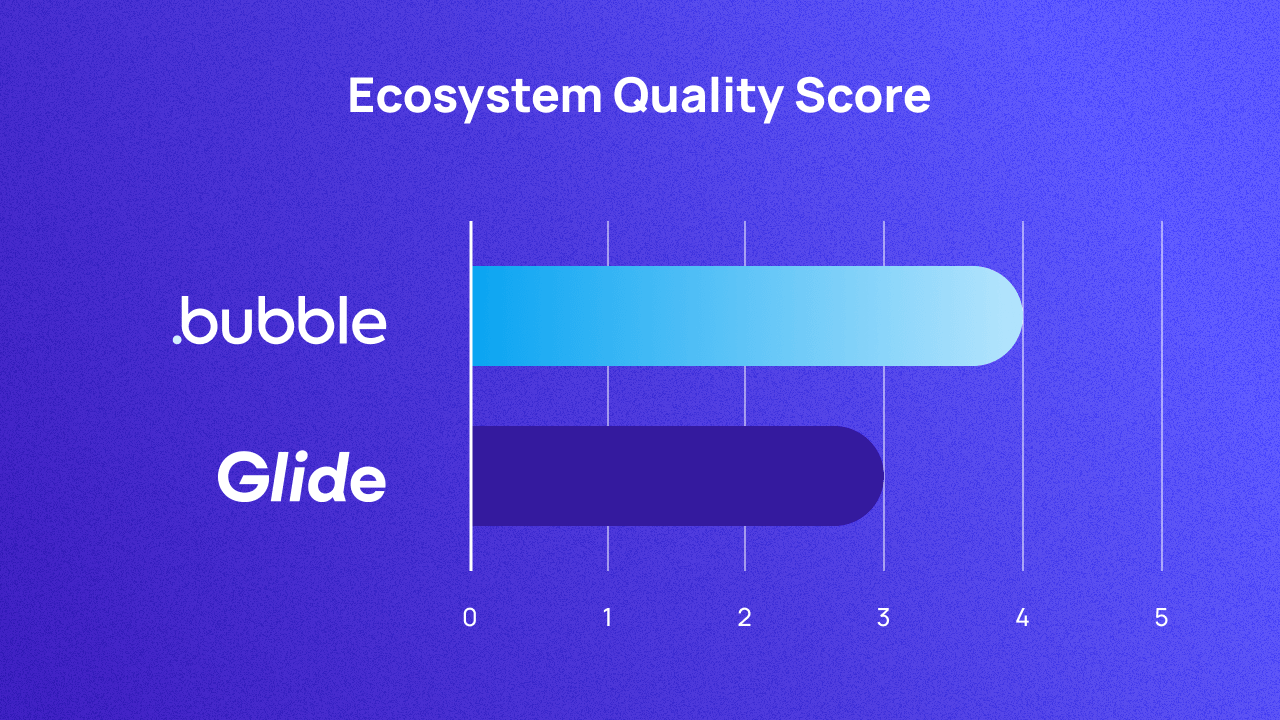
No platform should be an island. Your chosen platform’s ecosystem — the variety of third-party tools, services, partnerships, and extensions — can make customization and scale for your app simple or next to impossible.
Our ecosystem scores are based on:
- What third-party services a vendor offers
- The third-party products that have been created
- How accessible they are
- Established partnerships
| Score | Criteria |
|---|---|
| 1 | Minimal third-party services that are challenging to use |
| 2 | Minimal third-party services, but they’re easier to use |
| 3 | Robust third-party services, but they’re challenging to use |
| 4 | Strong strategic partnerships; robust third-party services, but not perfectly seamless |
| 5 | Strong strategic partnerships; robust third-party services that are easy to use |
How Glide stacks up: Glide offers several plugins and integrations. While they’re easy to use, many of them are pretty basic. Some users say the integrations and plugins are sufficient for their needs, but others say they don’t go far enough. Users call out the Stripe integration in particular, which only directs users to a Stripe landing page rather than accepting in-app payments.
If you mostly need Glide’s spreadsheet-based data functionality to convert business data into a functioning app, you may find their plugins and integrations sufficient. It’s important to make sure the integrations or plugins you need exist (and do what you need them to) before committing to the platform.
Glide’s ecosystem quality score: 3/5
How Bubble compares: Bubble has extensive native capabilities, but adding Bubble’s ecosystem takes it to a whole new level.
Bubble offers thousands of API integrations and plugins, so connecting your software with other tools and services is a seamless integration. (And if you want and know how, it’s possible to code your own plugins.) The Bubble community has created a massive, growing collection of templates. And our agency database helps you filter and compare agencies that use Bubble, so when you want to hire help, you can quickly find a partner that’s right for you.
Bubble also has a network of strategic partnerships with startup programs and universities including Microsoft For Startups, Harvard University, and Columbia University.
Bubble’s ecosystem quality score: 4/5
Glide vs. Bubble on cost
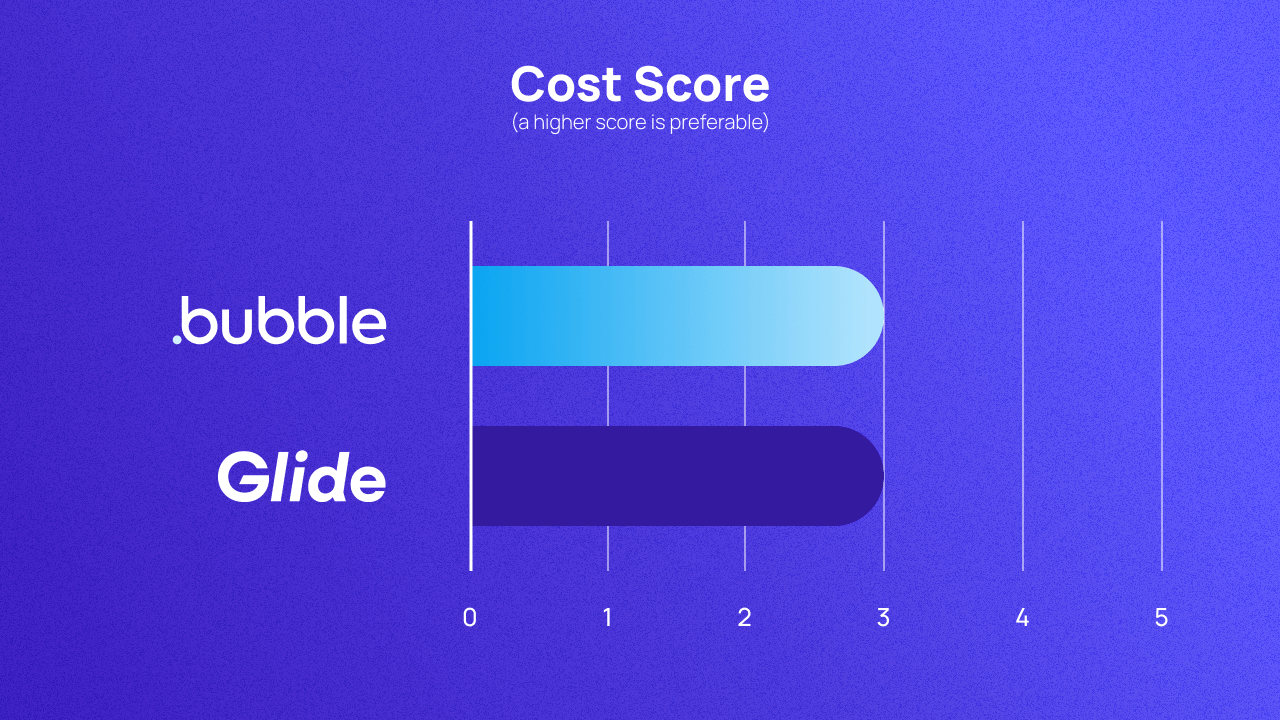
No-code development costs a fraction of traditional programming, but you’re still going to need to budget for it. Part of that is the cost of the platform itself, which can vary widely between vendors.
The grades we gave Glide and Bubble will help you evaluate the total cost of ownership, taking into account the pricing options and the platform's monthly price, as well as the cost in labor and workload of using the tool.
| Score | Criteria |
|---|---|
| 1 | No free tier |
| 2 | Free tier, deployment on custom domain costs more than $50 per month |
| 3 | Free tier, deployment on custom domain costs less than $50 per month |
| 4 | Free tier, deployment on custom domain costs less than $10 per month |
| 5 | Free deployment on custom domain |
How Glide stacks up: Glide offers a free plan that gives you limited access to build and launch your app for up to 10 users. It’s best for building personal databases and MVPs.
Paid monthly or annual plans use features-based pricing, which increases based on the number of users and editors your app will have, data sources and integrations in use, ability to custom code and add APIs, size of your database and frequency of updates, and more.
Because a “user” is counted as anyone who signs into your app each month, Glide can be prohibitively costly for apps who want to scale to a larger user base. For example, an app on the Business Plan with 100 users would cost $549 per month.
Glide’s cost score: 3/5
How Bubble compares: Bubble offers a Free plan, which gives you all the access to the platform you need up until you deploy your app, aka take your software live.
Paid monthly plans vary based on the workload demand of your software, the capabilities you need, and the number of app editors you have. Bubble uses a concept called “workload units” to account for usage instead of bandwidth, with various activities using a different number of these units.
Put simply: Bubble servers have to scale with your app as it grows, and that means pricing does, too. Plans start at $29 a month.
Bubble’s cost score: 3/5
Glide vs. Bubble on customizability
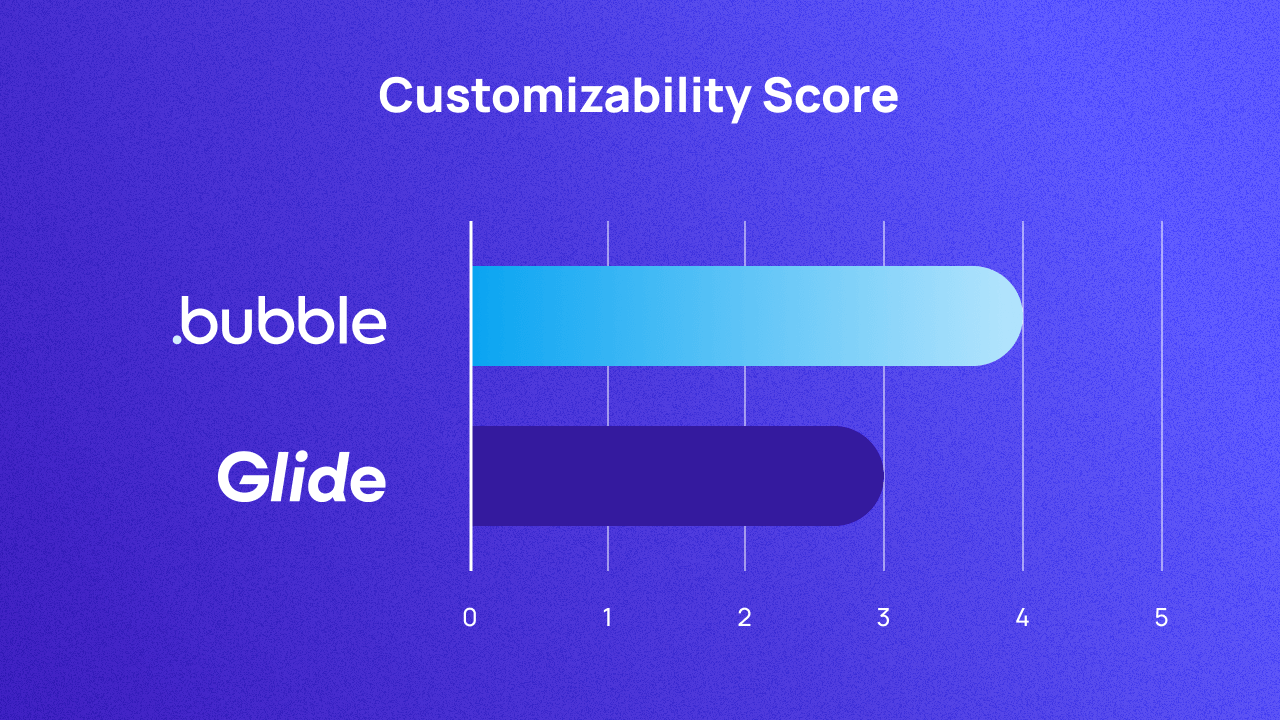
Of course, every no-code tool or platform offers some level of customization, but that level varies significantly. On some apps, customization is very basic, such as customizing colors or fonts on a template. On others, you may have complete control over logic and user interface design with both the visual editor and with custom code options.
The more customization options available to you, the more you can create with the platform. While templates are a great way to get started, they often can’t support specific use cases, niche edge cases, or even just accomplish your exact vision for the look and feel of your app.
The best no-code tools give you complete flexibility to create complex applications with unique features, either through its visual interface or an option to add custom code.
Our customizability scores are based on how flexible a platform is in terms of what you can build with it and how easy it is to add new features throughout your software’s lifecycle. We also considered the degree to which the platform lets you leverage AI to build and modify your app.
| Score | Criteria |
|---|---|
| 1 | Minimal ability to customize frontend, minimal ability to add new functionality, high level of difficulty to build beyond templates |
| 2 | Customizable frontend, minimal ability to add new functionality, limited generative AI assistance |
| 3 | Customizable frontend, open to adding new functionality, robust frontend AI use cases |
| 4 | Everything from 3, plus AI-generated logic and data schema |
| 5 | Everything from 4, plus conversational editing that allows for entire AI-generated apps |
How Glide stacks up: Glide scores a 3 on the customization scale, with some design and functionality customization available, but without extensive customization capabilities, especially in terms of data and logic.
For more complex customizations, Glide resorts to custom code, which is only available on the higher tiers of paid plans. That means full customization is difficult, requires technical knowledge, and is more expensive.
Glide’s customizability score: 3/5
How Bubble compares: By contrast, customization is a strong suit of the Bubble platform. If you can dream it up, you can build it on Bubble and add whatever capabilities and functionality you want. Bubble users have built everything from social platforms and marketplaces to KPI monitoring apps, apps that use generative AI, enterprise level internal tools, and more.
Plus, Bubble supports full customization directly from the visual editor, which means you can get more customization with less code. And if you do want to hard-code something with custom code, that’s always an option as well.
Bubble’s customizability score: 5/5
Glide vs. Bubble on compliance
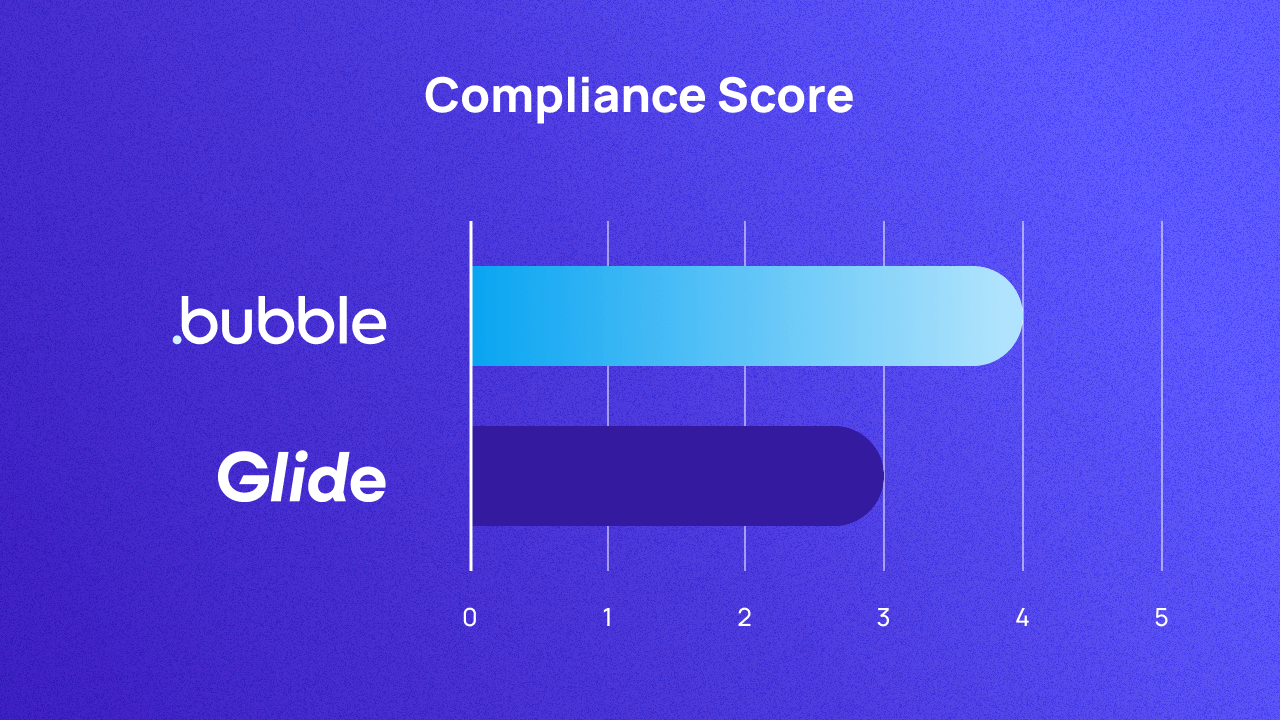
Depending on your use case, compliance could be a critical component of the software you intend to build.
For example, an internal app for your team to manage your Jira tasks might not need to have rigorous compliance standards. However, an app like BluBinder that helps users manage major life and financial decisions would need to comply with several specific regulations to protect user data.
Unfortunately, if the platform you’re building on isn’t compliant itself, it can be difficult or impossible to build a compliant app. Some no-code platforms have plugins or special instructions to guide you toward building compliant software, but that’s not always the case.
Our compliance scores are based on which standards the platform complies with by default, and whether each platform has a path to compliance. Higher scores correspond to more advanced standards.
| Score | Criteria |
|---|---|
| 1 | No stated native compliance certifications |
| 2 | No native compliance certifications, but either 1) can be made compliant with plugins or 2) gives instructions for hosted apps to become compliant by themselves |
| 3 | SOC 2 Type I compliant |
| 4 | SOC 2 Type II compliant or ISO 27001 compliant |
| 5 | SOC 2 Type II compliant and HIPAA compliant |
How Glide stacks up: By default, Glide complies with SOC-2 Type I and GDPR regulations. Keep in mind that you still need to implement the appropriate security processes in your build to keep your app compliant, but Glide has a series of docs that will help you use best practices to keep your data secure.
(Note: We conducted this year’s research in the summer of 2024, and since then, Glide has become SOC-2 Type II compliant. They’ll get a higher score in next year’s evaluation.)
Glide’s compliance score: 3/5
How Bubble compares: Bubble has built-in compliance with SOC-2 Type 2. While we’ve implemented numerous solutions to help protect your data, there are some additional steps developers need to take to build software that follows other frameworks like GDPR and HIPAA. Our series of compliance articles explain how to follow these standards when you build with Bubble. Plus, every Bubble pricing plan comes with access to some or all of Flusk’s best-in-class security-check features.
Bubble’s compliance sating: 4/5
Glide vs. Bubble on code ownership
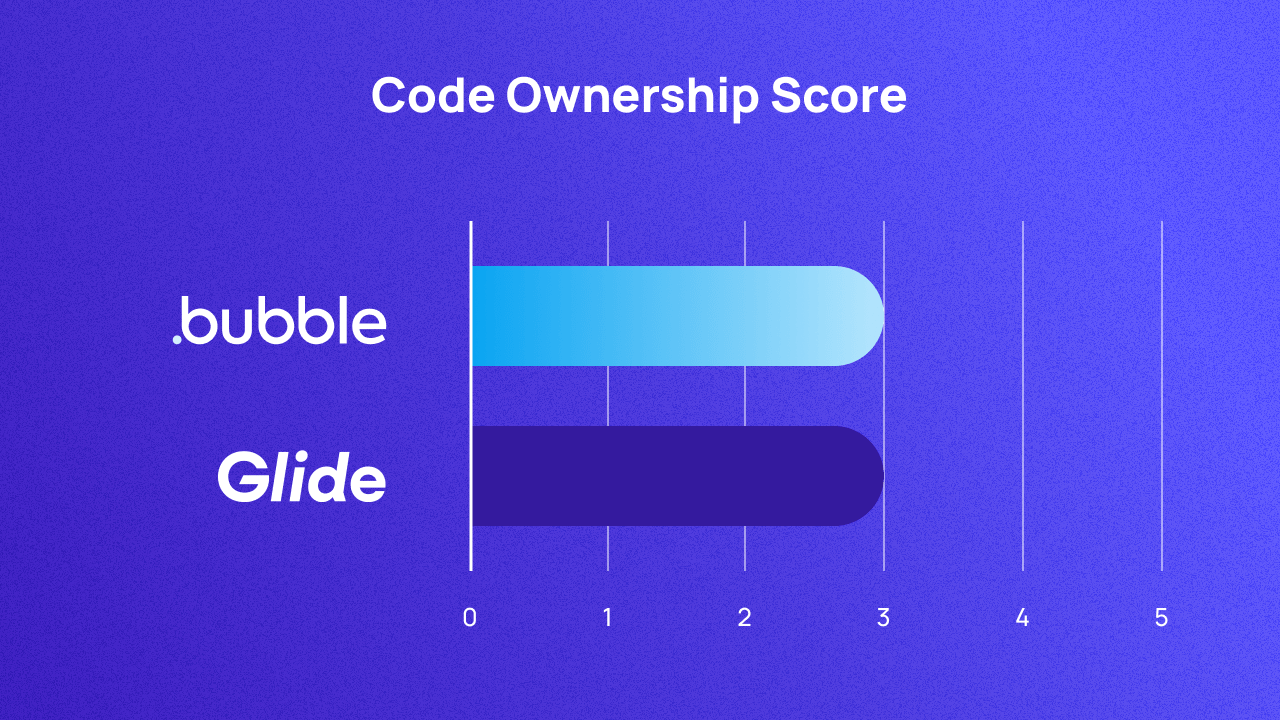
If you’re building more than just an MVP, it’s a good idea to build on a no-code platform that can support your growth and scale with you long-term. But even if you’re planning to stick with a platform long-term, it’s always a good idea to go into a build knowing what you can take out. Will you need to take your code elsewhere if your user base grows? Can the app support your vision for the long-term? What if your business outlives the vendor?
Our scoring criteria for the ownership category are based on how much freedom a platform gives you to export your work — specifically your code and your data.
| Score | Criteria |
|---|---|
| 1 | No exports supported |
| 2 | Allows partial data exports |
| 3 | Exports data, but not code |
| 4 | Exports data and code, but in limited languages and formats |
| 5 | Exports all data and code |
How Glide stacks up: With Glide, you’re the owner of your app and your data. If you have to leave, you can export your data, but not your code. Glide apps don’t have source code, per se, since they’re built on Glide templates and functionality, so there isn’t anything that can be exported aside from your data.
This can be a problem if your app grows beyond what Glide can support. Too many users on your Glide app can be costly, but you also won’t be able to export any source code and move it to another platform. Also, if the Glide platform were to shut down for any reason, there isn’t a way to get your code to move elsewhere.
Glide’s code ownership score: 3/5
How Bubble compares: Bubble lets you export your data freely, but you can’t export your code. When you build on Bubble, our platform’s proprietary source code enables your software’s functionality, so we can’t separate them without either breaking your software or releasing our source code.
Our promise to our customers, however, is that if your organization outlasts Bubble, we’ll release our source code under an open-source license.
Bubble’s code ownership score: 3/5
Glide vs. Bubble on learning curve
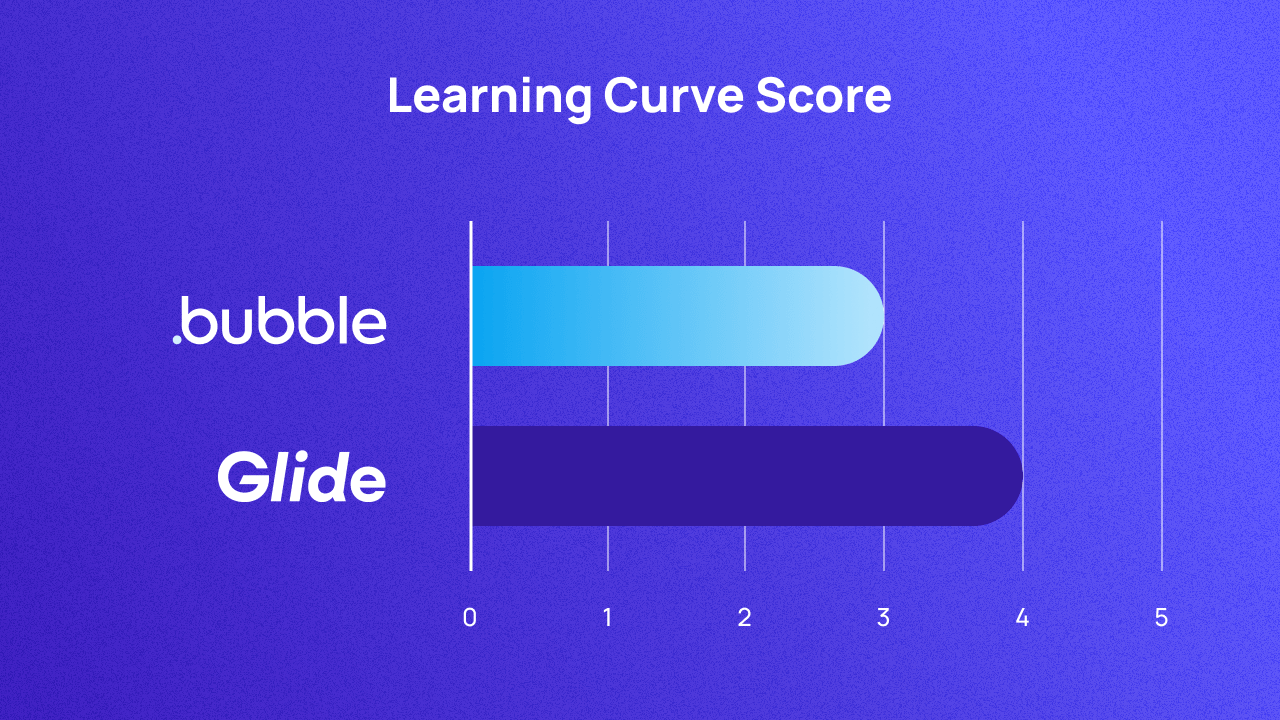
No-code development has made building software far more accessible, particularly for people who don’t have experience with traditional coding. But accessible doesn’t mean effortless.
After all, even basic platforms and technology require some onboarding time to learn your way around and figure out how to use it. Your background and experience with similar tools — or lack thereof — may impact your onboarding time, but it’ll almost never be zero.
With no-code, the platform you choose will have a significant impact on how steep your learning curve will be and how fast you’ll be able to build. Even with a visual programming language and drag and drop interfaces, some platforms require more coding knowledge than others.
In our State of No-Code Development Survey, the expected learning curve was a crucial factor for experienced and novice developers alike. Just 2.5% of respondents said the learning curve was “not important at all,” while 22% said it was “extremely important.” Learn more about how developers prioritized each factor in The State of No-Code Development 2024.
Our learning curve scoring criteria is based on how difficult a platform is to learn, and how fast you can start building.
| Score | Criteria |
|---|---|
| 1 | Extremely difficult to learn (comparable to learning code), demands significant technical knowledge, extensive time investment |
| 2 | Very difficult to learn, demands strong understanding of logic and some technical familiarity, extensive time investment |
| 3 | Moderately difficult to learn, demands moderate technical familiarity, moderate time investment (courses, tutorials, community support, etc.) |
| 4 | Somewhat easy to learn, demands minimal technical familiarity, allows you to start building on your first day |
| 5 | Extremely easy to learn, no technical familiarity needed, allows you to build something in your first hour |
How Glide stacks up: Glide’s interface is widely considered to be simple, intuitive, and easy to use and learn. The platform’s reliance on templates and user-friendly interface makes it easier to get up and running quickly.
That said, when it comes to more customization and complex apps, Glide can become more difficult — especially for those with non-technical backgrounds, as it requires more coding knowledge to get super customized. However, for basic app development that fits within their templates and use cases, learning to build is pretty straightforward.
Glide’s learning curve score: 3/5
How Bubble compares: Bubble is incredibly easy to get started with — especially if you start with the AI app generator. Describe the app you want to build in your own words and Bubble AI will create an overview of key features. Add, remove, or edit key features as much as you want, and generate when you’re ready. In moments, you’ll have a beautiful, responsive, and functional application that’s ready for you to iterate on. The overwhelming majority of prompts people use to start building with Bubble AI are as few as five words or less. So even with no experience and just a basic idea, you can start building your very own app.
It does take some time to learn all the ropes on how to manage and iterate your app in Bubble (although it’s much quicker and easier than learning how to manage AI-generated custom code). We provide a wealth of resources and a variety of paths to learn, but more importantly, our templates help you quickly turn straightforward ideas into fully-developed apps. A technical background helps you get more from the platform, faster, but you don’t need experience to hit the ground running.
Bubble’s learning curve score: 3/5
Glide vs. Bubble on education and documentation resources
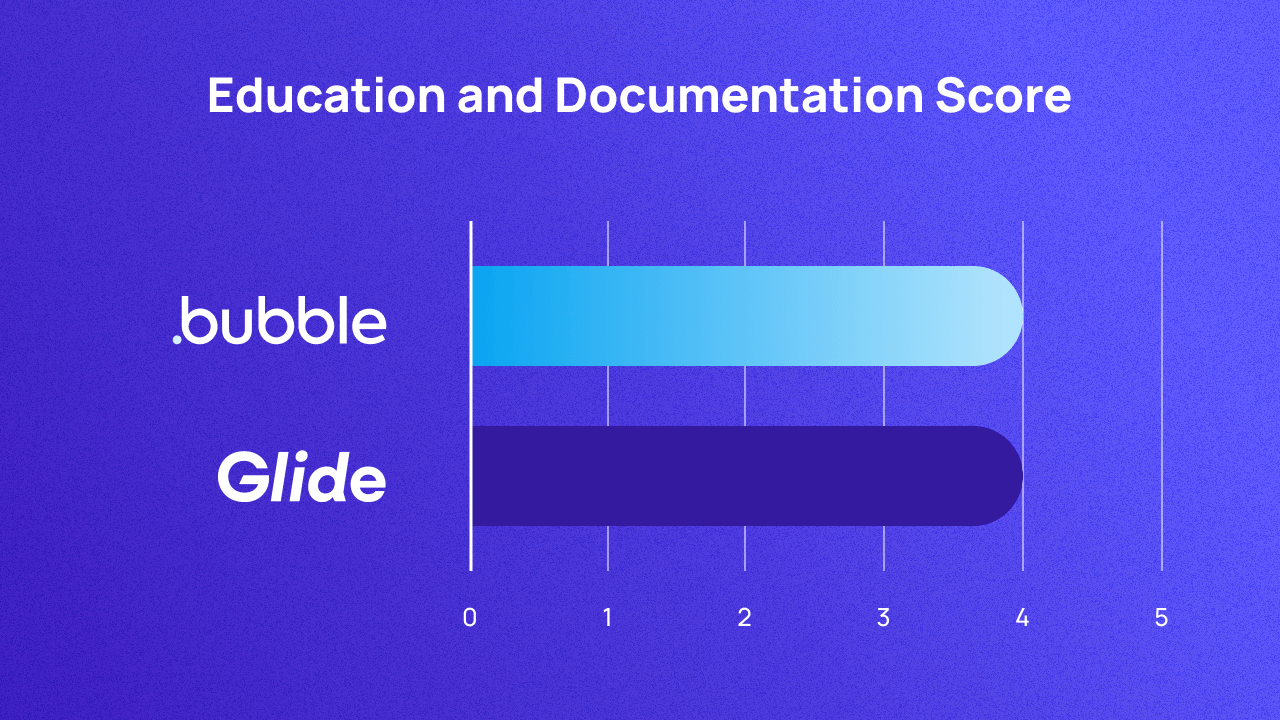
The more complicated the tool, the more comprehensive the directions, right? Not quite. With no-code tools, there is a lot of variability in how much documentation, education, tutorials and so on are available to guide you on your journey. For some tools, complete courses, certifications, and guides to just about every feature give you plenty of scaffolding as you learn. For others, you’ll have to rely on resources from other users or influencers to help you navigate beyond the basics.
A free response section of the State of No-Code Development 2024 survey asked respondents to share additional considerations that were a key part of the buying process. One out of every ten responses specifically referred to the importance of vetting the vendor’s educational resources.Our scores for a platform’s resources are based on the availability of first-party educational materials like guides and tutorials, as well as technical documentation.
| Score | Criteria |
|---|---|
| 1 | Low-quality educational resources |
| 2 | Medium-quality resources |
| 3 | High-quality resources, low coverage |
| 4 | High-quality resources, medium coverage |
| 5 | High-quality resources, comprehensive coverage |
How Glide stacks up: Glide offers “Glide University,” an in-one-place option to find courses, lessons, and documentation on the Glide platform. Aside from the official documentation, all of the Guide University content is video-based. There are a number of courses from the Guide team as well as lessons and videos from users and creators.
Glide’s resources score: 4/5
How Bubble compares: Bubble has invested heavily in building a library of both high-level educational content and technical support documentation. We have hundreds of videos, many tutorial articles, a comprehensive online user manual, and a series of courses for getting started.
Some vendors may have more topical coverage, but you’ll get plenty of quality resources with Bubble for any learning style or technical level. For example, you can watch a video about a specific skill or action, follow along with a tutorial article for a complete building guide, look up a question in the manual, or watch a video overview of specific functions of Bubble.
If you’re looking to really specialize in the platform, check out our Bubble Developer Certification program.
Bubble’s resources score: 4/5
Glide vs. Bubble on community
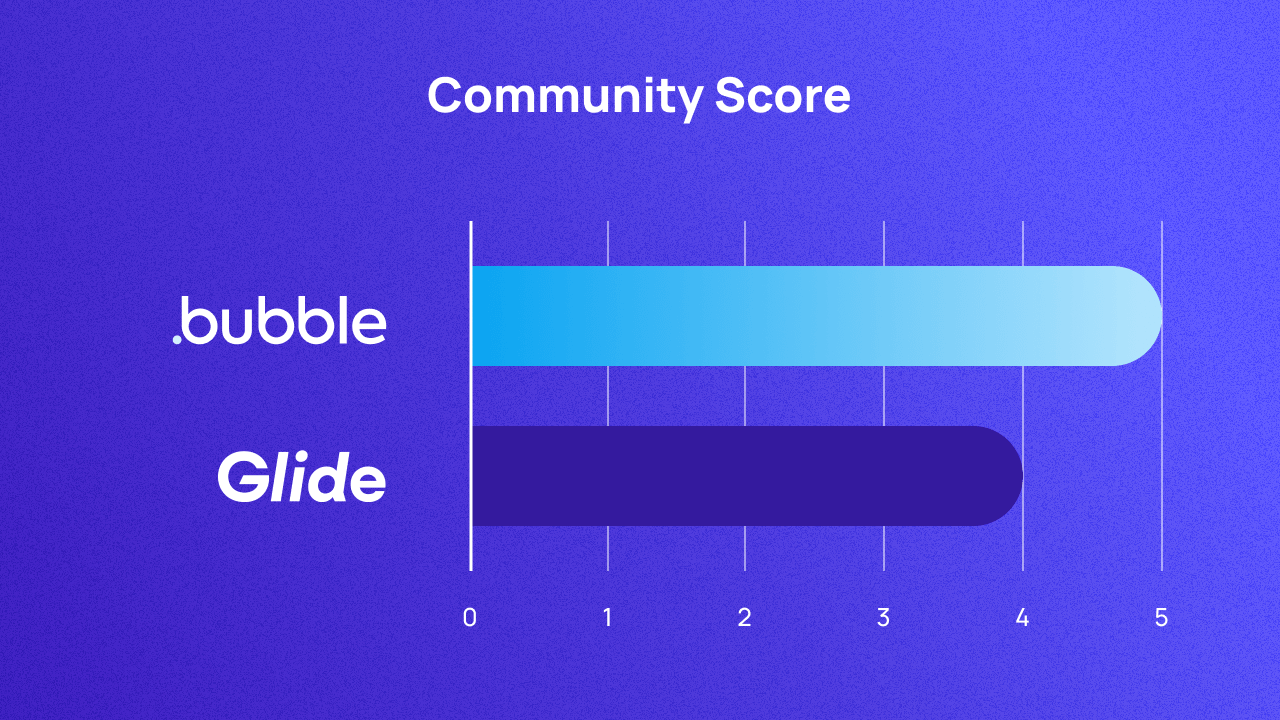
Since many no-code platforms and capabilities are relatively new and cutting-edge, there isn’t always a ton of traditional documentation available when something goes wrong.
When you run into a roadblock, get stuck building something, or have a concern, an active no-code community can help you troubleshoot or raise their voice with yours to bring your concerns and ideas to the platform’s leadership.
As such, it’s important to consider what kind and level of community engagement a platform offers. Is there an official community that the platform’s leadership is involved in and listens to? How many people are there, and how active is it? Where is the community hosted?
The more actively involved vendors are in the communities that form around their platforms, the more intune they can be with users’ needs and sentiments — and the more direct access you have to the people who make decisions about the platform.
Our scores reflect how active a platform’s developer community is and the degree to which the platform vendor participates in the community.
| Score | Criteria |
|---|---|
| 1 | No community channels |
| 2 | Community channels exist, but participation is low |
| 3 | Active community, some company participation |
| 4 | Robust community, regular and valuable company participation |
| 5 | Everything in 4, plus in-person company events |
How Glide stacks up: Glide has a forum available where you can get help and support from other engaged users, as well as report bugs and request new features. You’ll find about 100 posts per week from other developers and users, and the Glide team is fairly active in the “Report a Bug” channel.
Glide’s community score: 4/5
How Bubble compares: Bubble’s developer community is one of the platform’s most unique strengths. Not only does Bubble host a highly active forum where posts regularly see thousands of views and hundreds of comments, but Bubble users are also active on multiple subreddits, Discord groups, WhatsApp, Slack, Facebook, and more.
Bubble also hosts in-person events where you can connect and learn from other no-code developers and company leadership. And when there are important announcements, we make sure to share them with our followers on X and LinkedIn, too.
Bubble’s community score: 5/5
Bubble vs. Glide: which one is right for you?
Bubble and Glide are both great choices for no-code development. Both offer reliable performance, full-stack development, and engaged communities with solid learning resources for getting started.
Each platform shines for different use cases. Glide is best for more limited use cases when you’re looking for a quick, out-of-the-box solution with less customization needed. If you want to build an internal app with limited users based on existing data, Glide is super easy to get started with and provides a wealth of templates and resources. You can build the app yourself to meet business needs, or hire a Glide expert to build it for you in as little as four weeks.
However, outside of this narrow use case, Bubble’s your best choice, standing out in terms of customization, community, and versatility. On Bubble, you can build anything you can imagine. You have complete control over the design, data, and logic of your app, and you can build complex workflows, data schema, and logic that makes complex functionality possible. With a supportive and engaged community available on almost any channel — a specialized forum, Facebook, Reddit, Slack, and even in real life — you can connect with other founders and no-code developers for support, questions, feedback, and networking at any time. Our community also gives you a direct line of access to Bubble’s founders and teams — and we do love connecting with and hearing from Bubble users about what you’re building, what you need, and how we can best support your journey.
Whether you build from a template or start from a blank slate, Bubble gives you the tools and the flexibility to make an app that’s exactly what you dreamed of. You can use custom code at any point to get things just right — but you never have to, so non-technical builders and founders have just as much building power on Bubble as an experienced developer.
Our advanced visual programming is highly integrated with our broader ecosystem of third-party plugins, extensions, and templates, while Glide’s plugins and integrations fall somewhat short in terms of flexibility and customization options.
Want to see how Bubble compares to other no-code platforms? Check out some of our other comparisons:
Choose the no-code development platform that’s right for you
The no-code platform you choose completely shapes what your products and tools can actually do, the speed with which you can bring them to market, the ongoing impact development has on your budget, and the experience you’ll have for years to come.
Want to learn more about what goes into choosing a no-code development platform, along with a more detailed breakdown of the choices available to you? Check out our buyer’s guide to no-code development platforms.
The best way to decide which no-code platform is right for you? Try them yourself. You’ll see the difference, especially if you start with these comparisons in mind.
Build for as long as you want on the Free plan. Only upgrade when you're ready to launch.
Join Bubble






